8 Foods That Are Most Likely to Cause Food Poisoning, CDC Says

Food brings people together. Whether it’s a dinner party, a potluck, or a backyard barbecue, there’s really nothing quite like a shared meal. But that beautiful moment of breaking bread becomes a lot less beautiful if you find yourself waking up in the middle of the night with cramps and chills after eating something that didn’t agree with you. That’s why it’s essential to know which foods are most likely to cause food poisoning, and how you can keep yourself safe. The Centers for Disease Control and Prevention (CDC) says there are eight foods in particular that put people at a higher risk of falling ill. Read on for the full list, along with the safety measures you should take.
RELATED: 6 Things You Should Never Leave Out on the Counter, Food Experts Warn.
What is food poisoning?

Food poisoning is a type of illness that occurs when someone swallows foodborne germs by eating or drinking contaminated foods or beverages. The five foodborne germs that most commonly cause food poisoning in the U.S. are Norovirus, Salmonella, Clostridium perfringens, Campylobacter, and Staphylococcus aureus, according to the CDC.
If you get food poisoning, “your symptoms may vary, depending on the germ you swallowed,” the agency says. But some of the most common symptoms include diarrhea, stomach pain or cramps, nausea, vomiting, and fever.
“Some germs can make you sick within a few hours after you swallow them. Others may take a few days to make you sick,” the CDC notes.
How common is food poisoning?

The CDC estimates that 48 million people get sick from a foodborne illness in the U.S. every year.
“Most people have mild illnesses, but some infections spread by food are serious or even life-threatening,” the agency cautions.
Out of those 48 million annual foodborne illnesses, the CDC estimates that 128,000 people have to be hospitalized and 3,000 end up dying. Food poisoning can also lead to other concerning health problems, including meningitis, kidney damage, hemolytic uremic syndrome, arthritis, and brain and nerve damage.
“For some people, these health problems can last for weeks or months after recovering from a foodborne illness. For others, they never go away,” the agency says.
Since food poisoning can have serious or even fatal consequences, it’s important to recognize that “some foods are more likely than others to contain germs that can make you sick,” according to the CDC. Keep reading to find out which foods you should be extra cautious about.
RELATED: 7 Things You Should Never Keep in Your Fridge, According to Experts.
1
Poultry and meat
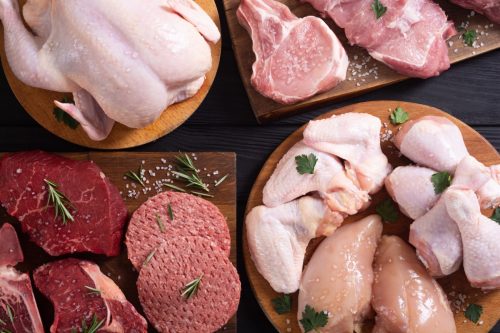
Raw or undercooked poultry (chicken and turkey) and meat (beef, pork, lamb, and veal) could put you in harm’s way. In the U.S., people eat chicken more than any other type of poultry or meat, according to the CDC.
“When cooked, chicken can be a nutritious choice, but raw chicken can be contaminated with Campylobacter, Salmonella, or Clostridium perfringens germs,” the agency says, adding that it’s estimated that 1 million people get sick from eating contaminated poultry in the U.S. each year.
To prevent this, the CDC says that poultry and meat should be cooked to a safe internal temperature. For all poultry, including ground chicken and ground turkey, this should be 165 degrees Fahrenheit.
“If you are eating chicken and notice the inside is still pinkish in color then I would throw it away,” dietician Jesse Feder, CPT, RD, tells Best Life. “If the chicken is not properly cooked through you are at risk for Salmonella, Campylobacter, and/or Clostridium perfringens exposure.”
But what about meat? Whole cuts of beef, veal, lamb, and pork should be cooked to 145 degrees Fahrenheit, while ground meat (including beef and pork) should be cooked to 160 degrees Fahrenheit, per the CDC.
2
Vegetables and fruits
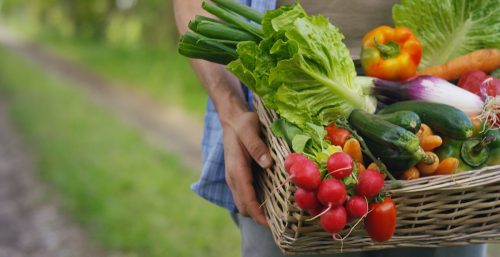
While fresh fruits and vegetables are an essential part of a healthy diet, they are also a major source of food poisoning—especially when they go unwashed. According to a 2018 study from the CDC, produce items are responsible for nearly half of all foodborne illnesses in the U.S., usually caused by Norovirus.
To protect yourself, the CDC says that vegetables and fruits are safest when washed and then cooked. Feder agrees, sharing that he recommends “thoroughly [washing] your fruits and vegetables after you buy them … The best way to prevent yourself from ingesting these bacteria is to thoroughly rinse and wash your produce you buy.”
In terms of specific produce, the CDC says that any raw or undercooked sprouts, such as alfalfa and bean, are a major risk for food poisoning.
“That’s because the warm, humid conditions needed to grow sprouts are also ideal for germs to multiply,” the agency previously warned. “Cook sprouts thoroughly to reduce your risk of illness.”
The CDC says that leaving cut melon out for more than two hours (or one hour if it’s exposed to temperatures hotter than 90 degrees Fahrenheit, like at a picnic or in a hot car) can put you in harm’s way as well. To avoid falling ill, the agency advises that all freshly cut melon be kept refrigerated, and that you only keep it in your fridge for seven days at most.
RELATED: How to Safely Store Vegetables to Keep Them Fresh and Tasty.
3
Juice
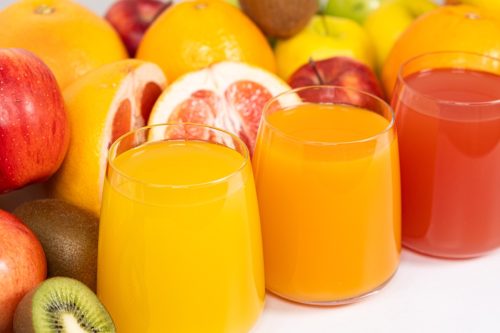
Most of the juice sold in the U.S. is pasteurized, or heat-treated, to kill harmful bacteria, according to the Food and Drug Administration (FDA). Even so, the agency cautions that some grocery stores, health food stores, cider mills, farmers’ markets, and juice bars sell juice or cider that has not been pasteurized, and this can lead to food poisoning.
To keep yourself safe, the CDC recommends sticking to pasteurized juice or cider. If you have unpasteurized juice or cider at home, the agency suggests bringing it to a rolling boil for at least one minute before drinking.
4
Milk

Officials say that unpasteurized milk and dairy products can carry the same risks, even though some people claim that raw milk products may provide health benefits.
“None of the claims made by the raw milk advocates that we have examined … can withstand scientific scrutiny,” the FDA tells consumers.
In fact, the CDC says that drinking or eating products made from raw milk can expose people to germs such as Campylobacter, Cryptosporidium, E. coli, Listeria, Brucella, and Salmonella.
“Choosing pasteurized milk and dairy products is the best way to safely enjoy the nutritional benefits of milk,” the agency reiterates.
5
Cheese
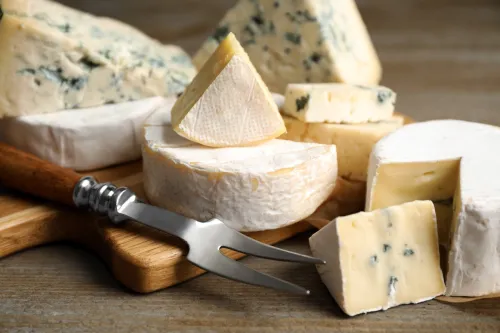
Soft cheeses made from unpasteurized milk are particularly risky as well. This can include queso fresco, brie, camembert, and blue-veined cheese—all of “which are more likely than hard cheeses to be contaminated with Listeria because of their high moisture, low salt content, and low acidity,” according to the CDC.
“These conditions support the growth of Listeria,” the agency further explains. “Soft cheeses made with unpasteurized milk or made in facilities with unclean conditions are even more likely to be contaminated. Although pasteurizing milk kills germs, cheese made with pasteurized milk can still get contaminated during cheese-making.”
To stave off listeriosis, the CDC says that it is safer to choose hard cheese, cottage cheese, cream cheese, string cheese, or processed cheese. If you want to eat soft cheese, the agency recommends only purchasing those that are clearly labeled as “made from pasteurized milk.”
RELATED: The Least Safe Ways to Cook Chicken, New CDC Reports Finds.
6
Eggs

Love a sunny-side-up egg? That choice could be putting your health at risk. Raw and undercooked eggs may be contaminated with Salmonella, which can cause food poisoning and lead to more serious illness or even death, the CDC says.
“Cook eggs until both the yolk and white are firm,” the agency advises. “Egg dishes should be cooked to an internal temperature of 160 degrees Fahrenheit or hotter.”
Foods that contain raw or undercooked eggs and cannot be cooked to a safe temperature—such as caesar salad dressing, raw cookie dough, and homemade eggnog—can put you at risk of getting food poisoning. In these cases, the CDC says you should make sure to use only pasteurized eggs.
7
Seafood

Raw or undercooked fish or shellfish (such as sashimi, sushi, and ceviche) is risky for food poisoning as well. To keep yourself safe, the CDC says you should cook fish to a safe internal temperature of 145 degrees Fahrenheit, or “until the flesh is opaque and separates easily with a fork.”
Shellfish should be “cooked until shells open during cooking or until flesh is pearly or white, and opaque,” according to the agency.
8
Flour
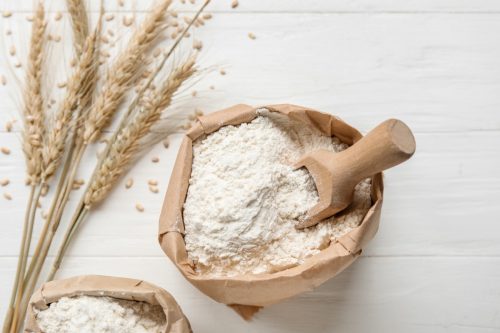
You probably already know you shouldn’t eat raw cookie dough because of the risk of food poisoning from raw eggs—but did you know you shouldn’t be eating raw flour either?
“Flour doesn’t look like a raw food, but most flour is raw. That means it hasn’t been treated to kill germs that cause food poisoning, such as E. coli and Salmonella. These harmful germs can contaminate grain while it’s still in the field or flour while it’s being made,” the CDC explains. “Steps like grinding grain and bleaching flour don’t kill harmful germs—and these germs can end up in flour or baking mixes you buy at the store. You can get sick if you eat unbaked dough or batter made with flour containing germs. Germs are killed only when flour is baked or cooked.”
For a safe choice, the agency recommends that you only eat food made with flour when it is cooked following the package directions or recipe. You should also stick to dough and batter that is made with heat-treated flour and pasteurized eggs, or that is labeled “edible” or “safe to eat raw.”
- Source: CDC: Safer Food Choices
- Source: CDC: About Food Safety
- Source: CDC: Symptoms of Food Poisoning
- Source: CDC: Chicken and Food Poisoning
- Source: CDC: Estimates of Foodborne Illness in the United States
- Source: CDC: Sprouts Food Safety Alert
- Source: FDA: Juice Safety
- Source: FDA: Raw Milk Misconceptions and the Danger of Raw Milk Consumption
- Source: CDC: Raw Milk
- Source: CDC: Listeria
- Source: CDC: Backyard Poultry
- Source: CDC: Raw Flour and Dough